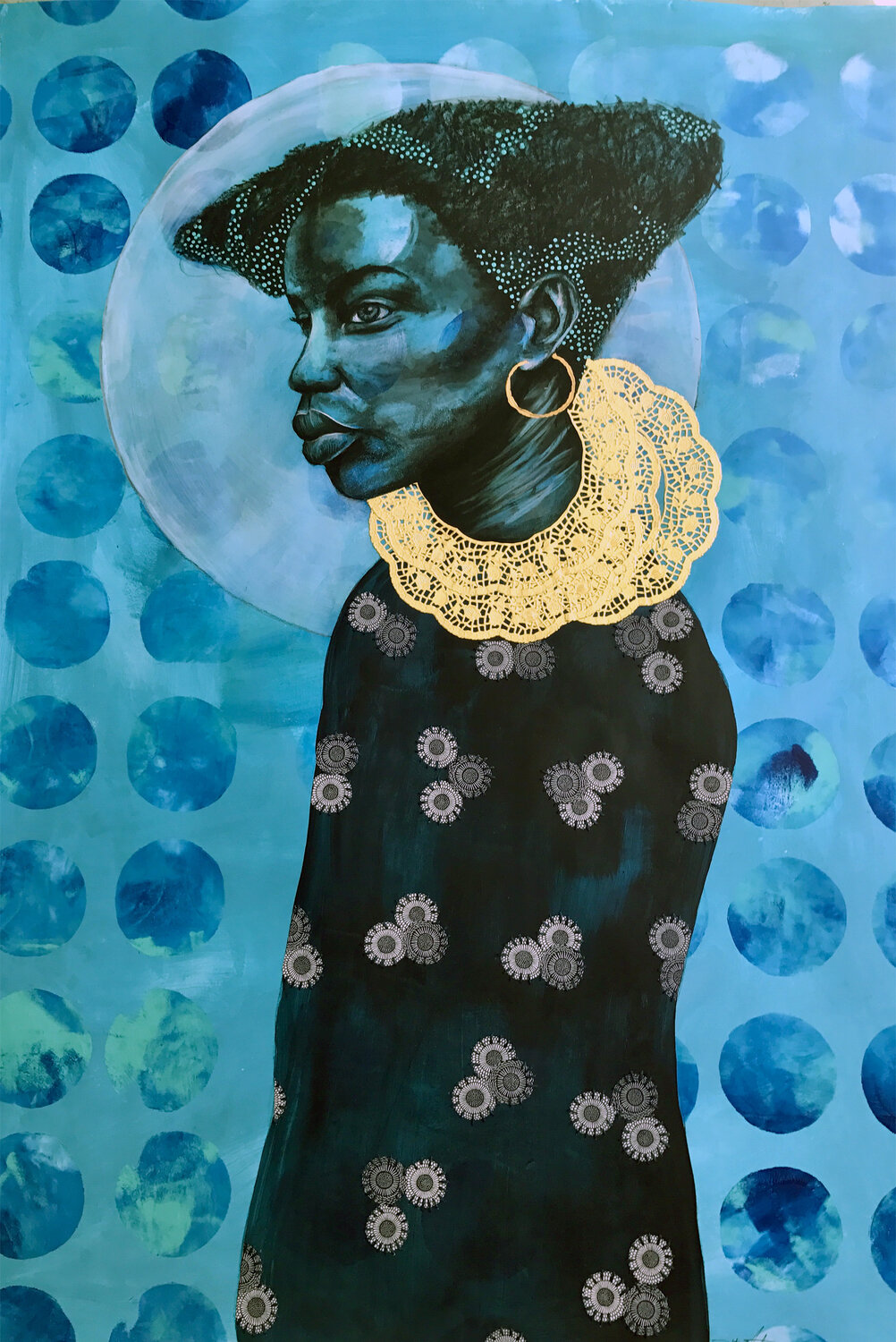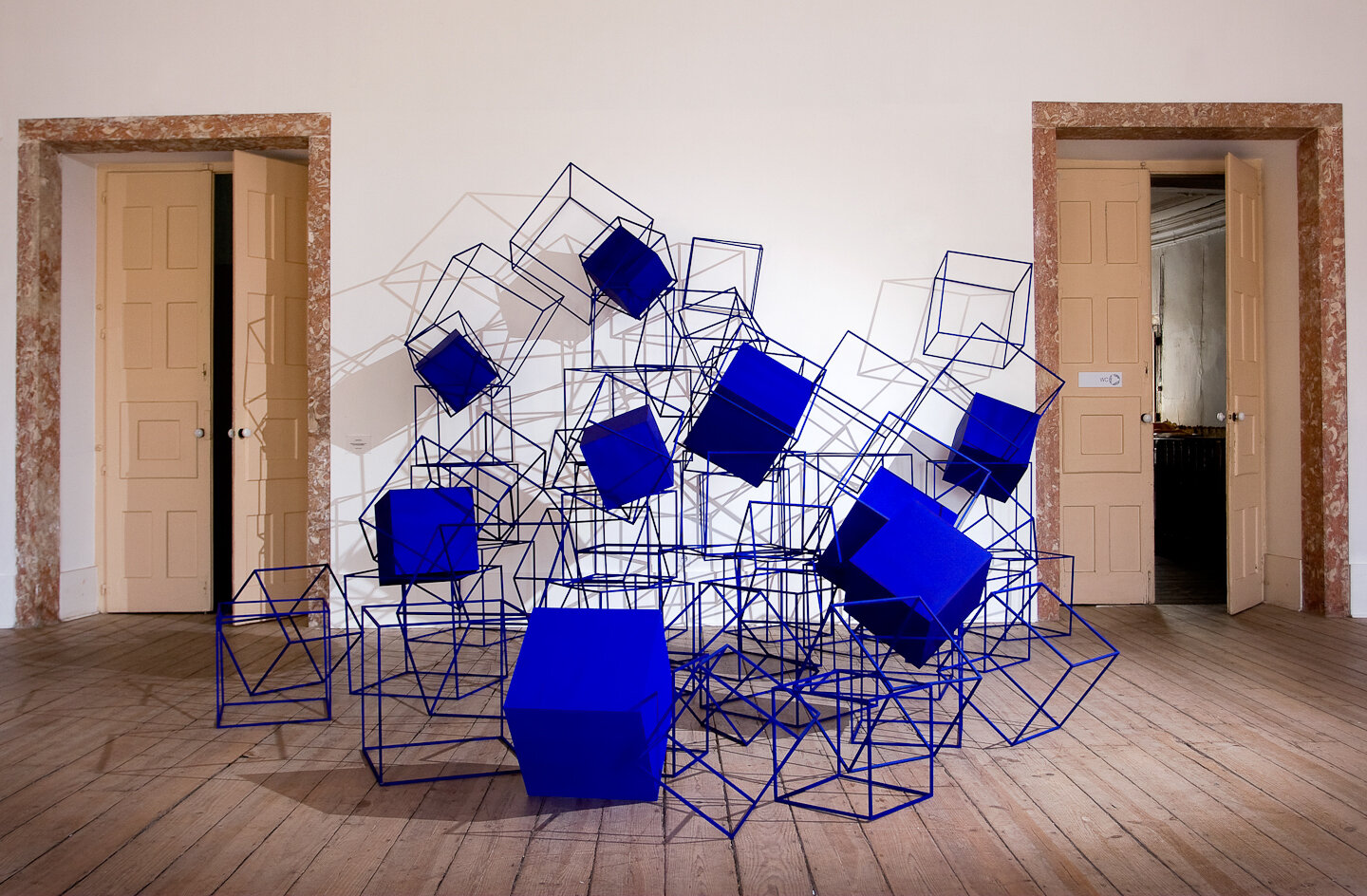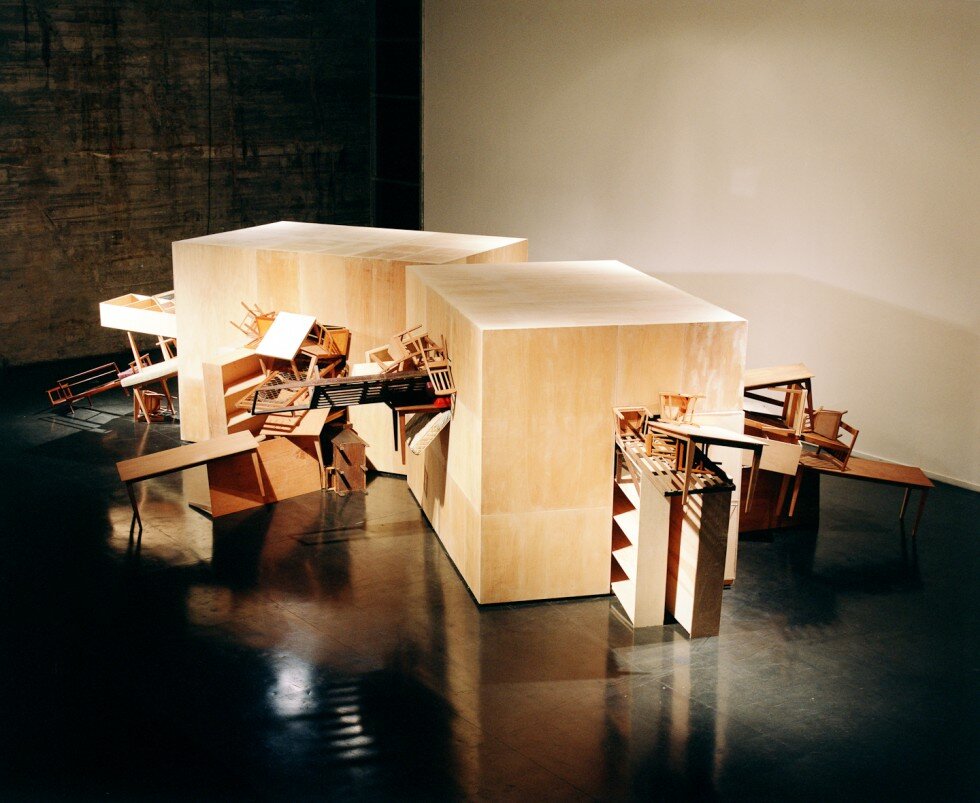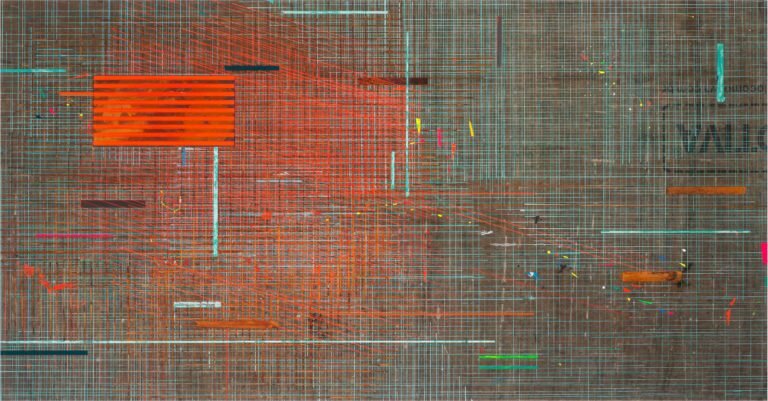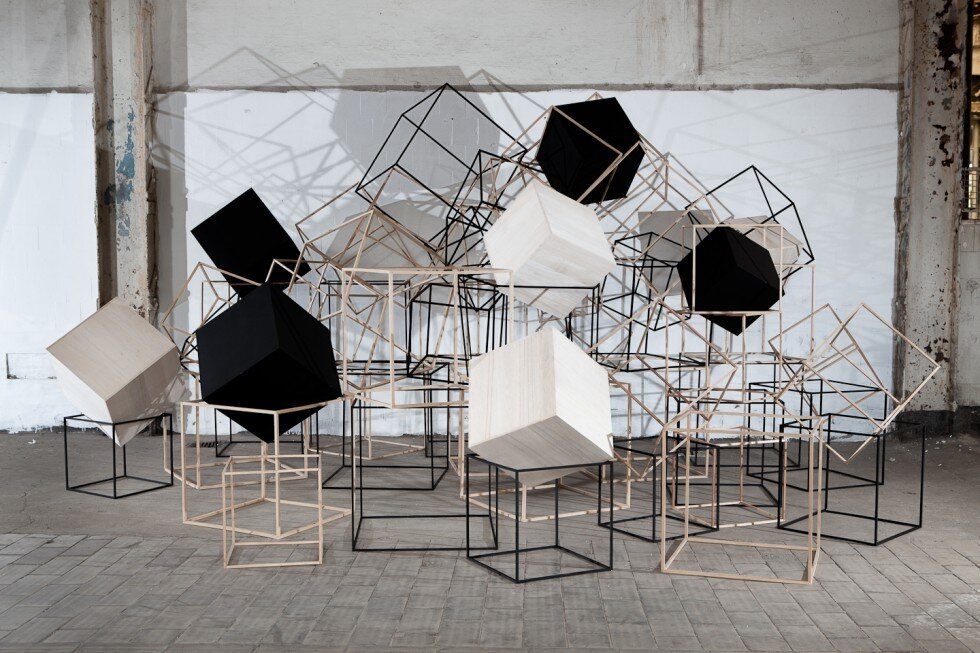Imagine a world where one’s race or class doesn’t provide a meaningful advantage toward their notoriety. We still have a while to get there. The good news is that today’s world is now taking notes on why inclusivity matters in art. Over time there has been an undermining of creative voices, especially those of women of color. These female artists haven’t been given an equal opportunity for the spotlight in all museums or galleries. By omitting their stories, there’s potential permanent damage to the history of art, which they are an important part of.
Delita Martin, Soul Keeper, 2016; Gelatin printing, acrylic, conté, hand stitching, and decorative papers on paper, 52 x 41 in.; Private collection; Photo by Joshua Asante.
Virginia Treanor, associate curator at the National Museum of Women in the Arts (NMWA), shares her thoughts on women of color artists’ importance. Also, two movers and shakers in the Latinx and Black art communities and beyond, artists Scarlett Baily and Tenbetee Solomon AKA Trap Bob join our discussion.
Solomon is a beloved artist in the D.C. community, who empowers viewers with her artwork to embrace authenticity and freedom. She has gained national notoriety by working alongside Refinery29, Giphy, Pabst Blue Ribbon, the Elizabeth Warren Campaign, BET, among others. She is also known for her eye-catching murals across the DMV area, and for promoting female creative opportunity through GIRLAAA.
Baily is a muralist and painter based in Mexico City. She intertwines cultural identity and cultural experiences. Baily showcases the duality of being Latinx from a personal and social perspective. She is also an advocate for women muralists through Mujeres Muralistas, a collaborative platform that brings attention to the street art form being embraced by female artists.
Know Your History
Suzanne Coley, All I Have, 2018; Artist’s book; Courtesy of the artist; On loan from Private collection; Photo by Emily Shaw, Courtesy of Betty Boyd Dettre Library & Research Center.
It wasn’t until the end of the 19th century that a woman of color made her mark in the art world for sculpture. Mary Edmonia Lewis, "Wildfire," was the first African American woman sculptor to achieve national and international accolades. Augusta Savage, a Black sculptor from New York of the 1900s, on the other hand, was rejected from an art program in France during 1923 because of her race, yet became one of the leading artists of the Harlem Renaissance.
Notwithstanding these two documented historical accounts, it is hard to fathom the full extent of unrecognized artistic talent lying dormant in women of color since the 19th century. Challenges persist today in the form of lack of exposure and opportunity. Being a woman of color myself, it is natural to desire to see your cultural peers’ names displayed by a painting or sculpture in a variety of art expressions.
The National Museum of Women in the Arts (NMWA) is a pioneering entity for representing all women, including women of color artists. During the past 30 years, they’ve held countless exhibits featuring such artists.
Treanor from NMWA comments:
There is no particular narrative that drives us to showcase a particular artist - it's the work itself that is the deciding factor. It's important not to pigeon-hole artists of color by showcasing work that is only about identity. There are many artists of color who make work that is not specifically about identity. This was explored in Magnetic Fields, which highlighted abstract works of art by African American and Caribbean women artists. Also, Colombian artist Fanny Sanín works exclusively in geometric abstraction.
Scarlett Baily in front of her beautiful mural in Mexico City.
Artists should get a fair shot at having their work displayed, without being corralled into an identity-based category. Sure, there are cultural aspects of works that allow audiences to learn more about the artist’s journey and reason behind the work. Fairness also calls for a delicate balance between works that represent culture and those that do not. Some artists do share their through cultural identity, as Solomon and Baily do, and that should be represented by art entities as organic expression without labels.
Baily expands on her vision of culture and art: “Everything I read about Mexico was negative, you never really heard about other things. I wasn’t really taught to value my own culture, but instead to negate the noise. This is when I felt the strong need to tell our story of what makes us unique, to talk about the journey, and to diversify how people are perceiving Latin culture. I felt I had so much work to do to recuperate this. You have to work from the heart. I hope my kids are born loving their heritage instead of having to recreate it. It’s okay to be bi-cultural. It’s cool and it’s a superpower. This is the time to use your art as a benefit.”
Making a Difference
Magdalena Cordero, Poems by Gabriela Mistral, Translations by Ursula K. Le Guin, Long Chilean Gaia, 2016; Artist’s book; Photo by Emily Shaw, Courtesy of Betty Boyd Dettre Library & Research Center.
There is so much depth to be explored artistically aside from how women of color choose to express their cultural identities. These artists should prominently be part of all museums and galleries as they are telling an important story, the artists’ story, that is frozen in time in their art. Through abstraction (like renowned artist Alma W. Thomas), minimalism (like Zilia Sánchez Dominguez), and installations (like Teresa Burga).
Solomon comments, "I think in the past women of color's voices were not accounted for as they are now, so it automatically will create change and influence moving forward. Our perspective and creativity is not subtle, it's impossible for us to not make noise. Most importantly, I think it will open the flood gates to other women of color wanting to enter the industry, but maybe never saw a place for themselves or didn't have anyone they could relate to, to look up to. I myself was in that position before I became an artist, never even thought it was a possibility for me. Now things are so different, it's beautiful and really gives me a sense of pride."
An inclusive stance creates a rich, collective art history, one that future generations will share and learn about. Inclusivity should, like justice, be “blind,” and that calls for more opportunities for women of color artists. Through fellowships, scholarships, art gallery and museum exposure, and in art careers generally.
TRAP BOB alongside her colorful, empowering artwork.
“There has clearly much more of a push among galleries and museums to showcase artists of color over the past few years - and women, too! As demonstrated in my response above, NMWA has been dedicated to doing this from its beginning (the museum opened in 1987) but we are thrilled to see such a commitment from other institutions and we hope that this trend will grow and continue,” says Treanor.
Treanor is right, as it is not a trend, it is a call for a consistent implementation of art practices going forward that will make a difference. The current need for more inclusiveness within the art world will lead to increased demand for women of color artists, which will then lead to two important things: increased value of women of color artworks and leveling out the legacy women of color artists leave behind as part of the collective art narrative, which will then become part of art history.
Baily recognizes recent changes in the art scene for women of color artists. “It’s changing. Female artists have fought their way to be in a man’s territory. It has been incredible to see this fearlessness, you just see that women are not waiting for permission anymore, they’re just doing it. For many years, we haven’t been celebrated the way we should have,” she points out.
According to artnet News, “Just 11 percent of all acquisitions and 14 percent of exhibitions at 26 prominent American museums over the past decade were of work by female artists. According to a joint investigation by artnet News and In Other Words, a total of 260,470 works of art have entered the museums’ permanent collections since 2008. Only 29,247 were by women.” An astounding fact that shows the challenges women artists face as a collective. These numbers also show the imbalance women of color artists face, as they make up a lesser percentage of the total works displayed by women artists.
Yes, things are improving and it’s important to constantly promote inclusiveness in the arts. Not just for artists, but also for people who work behind the scenes in the art community like curators, museum directors, and creative directors. The path is there for these women artists to have a bigger voice, but it needs a collective effort originating behind the scenes, including from those in prominent positions within the art world.
Today’s poem illustrates the hope and beauty that is found in diversity:
Give Me Your Hand
Give me your hand and give me your love,
give me your hand and dance with me.
A single flower, and nothing more,
a single flower is all we’ll be.
Keeping time in the dance together,
you’ll be singing the song with me.
Grass in the wind, and nothing more,
grass in the wind is all we’ll be.
I’m called Hope and you’re called Rose:
but losing our names we’ll both go free,
a dance on the hills, and nothing more,
a dance on the hills is all we’ll be.

